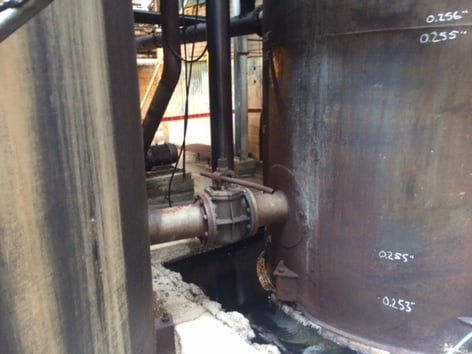Comprehensive Overview to Tank Welding Inspection for Safety And Security and Top quality
Comprehensive Overview to Tank Welding Inspection for Safety And Security and Top quality
Blog Article
An In-depth Overview of Container Welding Assessment Specifications and Methodologies for Improved Weld Top Quality and Efficiency
The significance of welding evaluation standards in the manufacturing of storage tanks can not be overstated, as they work as the backbone for ensuring weld integrity and operational dependability. Numerous inspection strategies, including visual analyses and progressed non-destructive screening approaches, are vital in determining possible problems that might endanger performance. In addition, sticking to regulative criteria not only boosts weld quality however likewise mitigates the danger of pricey failings. As we discover the nuances of these approaches, it ends up being critical to consider just how a systematic technique can revolutionize existing practices and result in significant renovations in results.
Relevance of Welding Inspection Criteria

Welding inspection requirements encompass a variety of requirements, including product requirements, welding procedures, and credentials of employees associated with the welding procedure. By implementing these standards, companies can methodically recognize and fix prospective problems, therefore lowering the probability of costly fixings or disastrous failings. Moreover, strenuous inspection practices cultivate a society of accountability and precision, encouraging welders to preserve high degrees of craftsmanship.

Common Welding Assessment Methods


Ultrasonic Checking (UT) is one more common strategy, utilizing high-frequency acoustic waves to discover internal defects that might not be visible externally. This approach is particularly effective for determining voids or incorporations within the weld metal. Magnetic Fragment Evaluating (MT) is likewise extensively made use of, especially for ferromagnetic products, as it exposes surface and near-surface defects with the application of electromagnetic fields and ferrous particles.
In Addition, Liquid Penetrant Testing (PT) identifies surface-breaking flaws by using a penetrant to the weld and afterwards utilizing a designer to attract out the penetrant. Each of these strategies adds to a comprehensive assessment strategy, guaranteeing that welds satisfy the rigorous top quality standards needed in tank building.
Governing Requirements and Compliance
Regulative standards and compliance are essential elements in ensuring the safety and dependability of welded frameworks in container construction - Tank Welding Inspection. These requirements serve to develop minimum demands for product homes, welding procedures, and assessment techniques, therefore reducing the threat of structural failings and boosting total performance
Key companies, such as the American Culture of Mechanical Engineers (ASME) and the American Welding Culture (AWS), give standards that are commonly adopted in the market. Conformity with these standards not just guarantees adherence to ideal practices yet likewise fulfills legal and legal obligations, securing the passions of stakeholders.
Regulatory bodies commonly mandate adherence to details codes, such as ASME Code Section IX for welding credentials and API 650 for welded storage tanks. These codes describe needs for welding strategies, qualifications of personnel, and testing approaches to verify weld stability.
Regular audits and inspections are essential to keeping conformity, as they assist identify inconsistencies from developed criteria. Non-compliance can description cause substantial fines, project hold-ups, and safety risks. Hence, a robust understanding of governing standards and a commitment to conformity are critical in webpage achieving top notch and long lasting welded container structures.
Non-Destructive Examining Approaches
How can the honesty of bonded frameworks be guaranteed without creating damage? Non-destructive testing (NDT) methods offer a robust remedy, allowing inspectors to assess weld top quality without jeopardizing the material - Tank Welding Inspection. Amongst the most usual NDT strategies are ultrasonic testing (UT), radiographic testing (RT), magnetic fragment screening (MT), and dye penetrant screening (PT)
Radiographic screening entails passing X-rays or gamma rays via the weld, producing pictures that reveal architectural issues such as splits or spaces. This method is important for analyzing the stability of complicated welds.
Magnetic bit testing is fit for ferromagnetic materials, where electromagnetic fields expose surface area and near-surface interruptions. Dye penetrant screening utilizes a liquid color to highlight surface-breaking imperfections, making it a reliable method for non-porous products.
Each of these NDT techniques has distinctive benefits, permitting comprehensive assessments tailored to specific products and welding processes. By executing these strategies, sectors can guarantee the integrity and safety and security of bonded structures, inevitably enhancing overall performance.
Enhancing Weld Top Quality Via Evaluation
Effective examination plays an important duty in enhancing weld top quality, acting as an essential checkpoint in my website the construction process. By determining prospective problems early, evaluations reduce the threat of jeopardized structural integrity and guarantee conformity with market requirements. Using a mix of aesthetic examinations, non-destructive screening (NDT) techniques, and mechanical analyses, assessors can spot problems such as porosity, cracks, and incomplete fusion.
Applying a robust evaluation procedure not only enhances the total high quality of welds but additionally cultivates a culture of responsibility among welders and producers. Routine training and qualification of inspection employees ensure that they are furnished with the essential abilities to recognize and attend to prospective issues efficiently. This positive approach decreases rework and linked prices, eventually adding to project effectiveness.
Moreover, extensive documentation of inspection searchings for offers important understandings right into recurring issues, promoting continual enhancement in welding methods. By leveraging innovative technologies, such as automated ultrasonic screening or electronic radiography, weld high quality can be boosted with much more specific assessments. To conclude, a rigorous examination procedure is crucial in accomplishing premium welds, making certain safety and security, integrity, and longevity in tank construction.
Verdict
To conclude, the implementation of rigorous container welding evaluation requirements and techniques is important for guaranteeing weld honesty and performance. By making use of a combination of visual examinations, non-destructive screening approaches, and adherence to regulative criteria, organizations can effectively identify and mitigate possible issues. Fostering a culture of responsibility amongst welders further enhances the top quality of welding processes. Inevitably, these techniques add to minimized architectural failings, lower repair work prices, and improved functional performance within the sector.
Report this page